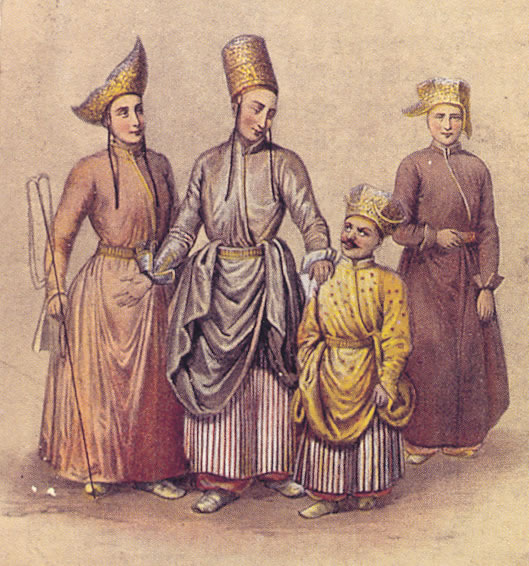|
Osmanlı Devletini Cihân Devleti Yapan Kurum: Mekteb-i Enderun
Osmanlı sarayı Birun, Enderun ve Harem olmak üzere üç bölümden meydana geliyordu. Ve Enderun; Harem ile beraber Harem–i Hümâyûn içerisindeydi . Osmanlı tarihçisi Halil İnalcık’ın söylediği gibi Enderun, Osmanlı devletinin erkek yöneticilerinin yetiştiği üst düzey bir okuldur.
Yeni Bir Kültür Çevresinin Mensubu: Devşirme

Osmanlı devlet geleneğinin oluşmasındaki en köklü kurum, şüphesiz Enderun’dur. Farsça bir kelime olan Enderun, “iç kısım” anlamına gelmektedir. Enderun’un kadınlara yönelik olan muadil eğitim alanı ise Harem’dir.
Slav dillerinden başlayıp da Yunanca ve Arnavutça konuşulan bölgelerden gelen insanların, bir sarayın dili, üslubu ve icraatı çevresinde kenetlendiği ve bir araya geldiği merkez Enderun’dur. Burada yetişen kişinin, eski dili, dini ve kabilesi ile olan bağlantısı zamanla mesafelenir. Çünkü o, artık yeni bir kültür çevresinin mensubu olma yolundadır.
Enderun’a alınan çocuklar, Osmanlı’ya özgü bir sistem olan “devşirme” denilen bir yöntem ile seçilir ve istihdam edilir. Ancak bu ergenlik dönemi gençler, Enderun’a kabul edilmeden önce alt bir eğitim safhasından geçmeleri gerekirdi.
Hıristiyan aile çocukları içinden seçilen bu çocuklar, saray okuluna girmeden önce, Müslüman Türk ailelerinin himayesinde Türkçe’yi, İslâm inanç ilkeleriyle âdâp ve muaşerete yönelik uygulamaları öğrenirler. Akabinde Edirne, Galatasaray, İbrahim Paşa saraylarında bedenî ve ruhî yeteneklerini ilerletecek dersler ve usulleri ikmâl ederlerdi. Acemi oğlanları, eğitim ve öğretim sonucunda “çıkma” ismiyle ayrılarak değişik yerlerdeki askerî birliklere gönderilirler; üstün kabiliyetli gençler ise yüksek derecede bir eğitimi alması amacıyla Enderun’a kabul edilirlerdi.
Osmanlı yönetim anlayışında, devşirme denilen usul, sistemli bir geleneğin işaretlerini verir. Devşirmeyi gerçekleştiren en önemli şahıs devşirme emini, bu seçimi yaparken, tek çocuklu ailelerin ve tek oğlan çocuğu olan ailelerin mensuplarını devşirmez. Hatta devşirme için, köy ahâlisinin rızasının alınması toplumsal bir sözleşmenin dumura uğramaması için bir zorunluluktur.
Devşirmenin gerçekleştirildiği bazı bölgeler, son derece fakir ve gelecekleri için çok iyi fırsatların gözükmediği köyler olabiliyordu. Kafkasya, Arnavutluk veya İşkodra’nın dağlık coğrafyasından gelen çocukların yeterli beslenme, eğitim ve iş bulma imkânları çok güç bir durumdu. Böyle bölgelerde yaşayan aileler, çocuklarının istikbalinin kurtulması için devşirme eminini beklerlerdi.
Gönüllülük esasına dayanan devşirme, ailelerin onayı ve rızasıyla gerçekleşir. Asla çocuklar ailelerinden zorla kopartılma yoluna gidilmezdi. Devşirilen çocukların bir kısmı yeniçeri neferi olabildiği gibi, bazıları da Sokullu Mehmet Paşa ve Mahmut Paşa gibi devletin yönetiminde söz sahibi olan başvezir olabilmekteydi.
Ulema ve özellikle çok yetenekli olan devşirme eminleri, devşirme için izin istedikleri aileleri “Çocuğunuzu verin. Müslüman olsun, bu sizin için de iyidir, bizim için de iyidir” diyerek ikna ederler. Meselâ devşirilmeden önce, Sokullu Mehmet Paşa, çok meşhur ve bilgili Hıristiyan bir ruhbanın çocuğudur, ancak sonraları çok iyi bir Müslüman olmuştur. Sistemin en dikkat çeken yönü de buradadır.
Her Türlü Eğitimin Verildiği Mektep
İçinde sınıf bulunan bir mektep gibi olmayan Enderun’da, çocuklar, bir tür hizmet içi eğitim alırlar, koğuştan koğuşa konumlarından terfi ederek mertebe kaydederler. Vasıf ve kabiliyetleri geliştikçe, padişaha daha yakın hizmetlere yükselirler. Sözlü ve yüz yüze bir eğitim alınan Enderun’da, spor, resim, hüsn-i hat ve edebiyat gibi yetenek geliştirici sahalarda nitelikli dersler verilirdi.
Bir hayat tarzı olan devşirme usûlü sayesinde, alınan çocuklar Türkçe öğrenirler. Enderun’a kabul edilmeyenler bile, İstanbul civarındaki köylerdeki köylülerin yanına geçici bir süre için verilirlerdi. Balkan dil ve kültürüyle belirli yaşlara gelen çocuklar, bir müddet sonra, Osmanlı lisanına ve yaşam biçimine aşina bir hale gelirlerdi. Yeniçeri adayı da olan bu çocuklar için, Türkçe öğrenmek ve din bilgisi almak önemlidir.
Devşirildikten sonra beden ve zeka bakımından kabiliyet ve yeteneklerinde gelişme olan çocuklar, yüksek derecedeki bir eğitim için Enderun’a gönderilirler. Diğerleri ise, çeşitli askerî sahalara dağıtılırdı. Endurun’a alınan devşirme çocuklar, çetin bir hayatın yaşandığı bu saray okulun’da, Osmanlı kültürü ve İslâmiyet konusunda yetkin ve donanımlı hocalar tarafından yetiştirilirlerdi.
Her Türlü Eğitimin Verildiği Mektep
İçinde sınıf bulunan bir mektep gibi olmayan Enderun’da, çocuklar, bir tür hizmet içi eğitim alırlar, koğuştan koğuşa konumlarından terfi ederek mertebe kaydederler. Vasıf ve kabiliyetleri geliştikçe, padişaha daha yakın hizmetlere yükselirler. Sözlü ve yüz yüze bir eğitim alınan Enderun’da, spor, resim, hüsn-i hat ve edebiyat gibi yetenek geliştirici sahalarda nitelikli dersler verilirdi.
Bir hayat tarzı olan devşirme usûlü sayesinde, alınan çocuklar Türkçe öğrenirler. Enderun’a kabul edilmeyenler bile, İstanbul civarındaki köylerdeki köylülerin yanına geçici bir süre için verilirlerdi. Balkan dil ve kültürüyle belirli yaşlara gelen çocuklar, bir müddet sonra, Osmanlı lisanına ve yaşam biçimine aşina bir hale gelirlerdi. Yeniçeri adayı da olan bu çocuklar için, Türkçe öğrenmek ve din bilgisi almak önemlidir.
Devşirildikten sonra beden ve zeka bakımından kabiliyet ve yeteneklerinde gelişme olan çocuklar, yüksek derecedeki bir eğitim için Enderun’a gönderilirler. Diğerleri ise, çeşitli askerî sahalara dağıtılırdı. Endurun’a alınan devşirme çocuklar, çetin bir hayatın yaşandığı bu saray okulun’da, Osmanlı kültürü ve İslâmiyet konusunda yetkin ve donanımlı hocalar tarafından yetiştirilirlerdi.
Kaynakça
- İlber Ortaylı, Osmanlı Yeniden Keşfetmek, XV. baskı, İstanbul 20006.
- Halil İnalcık, Devlet-i Aliyye Osmanlı İmparatorluğu Klâsik Çağ [1300-1600] IV. baskı, İstanbul 2004.
------------------------------------------------------------------------------
Enderun School

The Neo-classical Enderun library
Enderun School (Turkish: Enderun, Ottoman Turkish: اندرون مکتب, Enderûn) which meant "inner most" was a free-boarding school for the Christian millet of the Ottoman Empire, which recruited students via Devshirme (Ottoman Turkish= Devşirme) - an enculturation system of the Christian youngsters for learning the characteristics of the Islamic society and the unique culture of the Ottoman palace. Enderun was fairly successful in creating the multicultural bureaucracy, which is reflected in multicultural Ottoman Statesmen. Enderun School functioned for academic and military purposes, as well. Ideally the graduates were permanently devoted to government service and had no interest in forming relations with lower social groups. The Enderun School was not merely a building or a school but a system of education that became the pioneer educational institution in gifted education and was the first of its kind. The Enderun system was also significant as an early model of multiculturalism because students from different ethnic backgrounds were brought together and learned to live together under a common ideal. The multicultural environment of Enderun had a positive influence on the peace and harmony created in Ottoman States until the decline of the Empire. Enderun’s gifted education program is defined as the world’s first institutionalized education for the gifted
Edited (7/11/2012) by tunci
|


